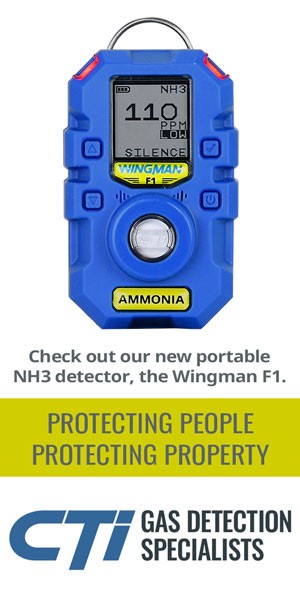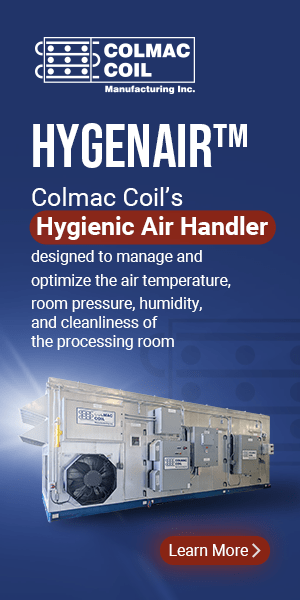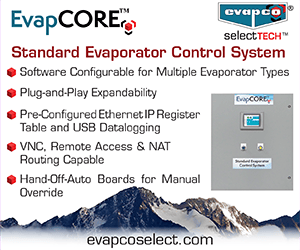ONSITE TO ONLINE. HOW THE PANDEMIC IS CHANGING TRAINING AND SUPPORT
“State and local policies have either prevented or significantly limited inperson gatherings that would be typical of in-person training and development,” said Doug Reindl, a professor at the University of Wisconsin and a principal with the Industrial Refrigeration Consortium. “In addition, many corporations have crafted their own policies that prohibit non-essential employee travel and participation in events that would include these types of gatherings.”
Benjamin Weser, manager, educational services at Emerson, which manufactures commercial and industrial refrigeration products, said that even though in-person training opportunities are limited, the need for training hasn’t gone away. The industry had to quickly pivot to leverage other training solutions, such as streaming video, online self-paced courses and real-time webinars. “In fact, with many people staying home, there’s been a window of opportunity for professional development,” he said.
While the methods that industry educators use to deliver training during the pandemic have shifted, the goals remain the same. “We want to identify the learning needs of our customers and provide solutions that instill the knowledge and skills that will enable them to do their work effectively and efficiently,” Weser said. “The limitations that currently apply to in-person training events provide an opportunity for educators in the industry to evaluate the virtual and on-demand training and support we offer our customers.”
ONLINE LEARNING OPPORTUNITIES
Dave Schaefer, chief engineer for Bassett Mechanical, which provides custombuilt mechanical contracting, metal fabricating and maintenance service solutions, said many of the industry’s virtual learning capabilities were already in place. “This has forced us to use it, because in person isn’t an option right now,” he said. “It is forcing us to evolve and change”
Azane, a manufacturer of low-charge ammonia refrigeration solutions, has Web-based training courses that it regularly uses for various training topics. “The primary benefit is that they can be accessed 24/7 and reviewed several times to gain and maintain the required level of understanding and competency,” said Caleb Nelson, vice president of development for Azane Inc.
Like many companies investing in training, Emerson said it already has a learning platform that enables the company to deliver learning virtually. Still, the company is now leveraging more of the system’s capabilities, such as hosting video training events via its learning management system, due to social distancing requirements. “This lets us include activities like instructor equipment demonstrations via video, participant break-out group activities and quizzes,” Weser said. “COVIDrelated limitations to in-person learning events highlight the need for companies to ensure that customers have multiple avenues for accessing information, support, and training on our products and solutions.”
Weser said the use of Emerson’s online learning platform has grown since COVID limitations began. “Beginning in April, we offered a promotion providing free access to a large chunk of our online training library and delivered a series of live online training courses,” Weser said. “Since that time, we’ve had over 3,000 new user registrations on our website and over 7,000 online courses completed by those users. I think that reflects the enthusiasm among industry technicians for continuous learning on technical topics and a comfort level with using new technologies to participate in that training.”
Schaefer said that nothing is as constant as change. “We’re experiencing it at an accelerated pace because it has been required of us to do it,” he said. “There are some folks out there that have relied so heavily on face-toface over the years, they’re having to scramble to understand how to get the class, conduct it and get the important information out to the students.”
EFFECTIVE TRAINING
When creating an effective online learning experience, there is more to consider than simply setting up an account on the various platforms available for remote meetings and presenting the content virtually rather than in a classroom, Reindl said.
Reindl said each of the different platforms available for delivering training and professional development online has its own strengths and weaknesses, and there is no single solution that can meet all of the varying needs for each course event. “This can make it a challenge for the organization delivering the training to pick a single platform or technology,” he said.
Customers need training that is current and relevant to the work they’re doing. “Learners are less likely to retain information that they don’t feel is applicable to their job,” Weser said. “Learning essential service skills is always a value-add, but technicians also need learning that will keep them up to date on emerging technology.”
Successfully delivering educational content online starts with having course instructors who are intimately familiar with teaching adult learners and developing and delivering educational content geared towards adults, Reindl said. “This includes establishing clear learning objectives for the course overall, based on the defined audience the training event is aiming to reach. The overall course learning objectives are then supported by the individual elements of the course with their own learning goals,” he said.
Adults learn best when they’re actively applying what they’re learning. Therefore, manufacturers need to make training and support available to our customers that can be accessed on-demand, when its most needed and when it is being put directly into practice, Weser said
Reindl said instructors should think of the overall course objective as building a wall. “The individual modules of the course are the bricks, and each one needs to be appropriately sized, configured and arranged. The foundation represents the knowledge, skill, and capabilities of the instructional staff. Without a strong and functional foundation, the wall will be of no use,” he said, adding that each of the elements of the wall has to function together to create a finished end product that is structurally sound, functional and even aesthetic.
Keeping remote learners engaged is important and having opportunities for participants to interact with instructors synchronously delivering content is essential and is one strategy to keep them engaged, Reindl said. “Another facet of course engagement is having exercises or assignments that attendees work on between synchronous sessions. These ‘homework problems’ can be effective tools to reinforce concepts being present during the course,” he said.
Schaefer said online programs need to have a feedback mechanism so the providers can know if an attendee understood the lesson. “You can tell a lot if you’re with someone training them. You can tell if they understand from the visual, face-to-face interaction,” Schaefer said. “If training is on the phone or if someone is watching a video, it is difficult. We have to make sure through some means of feedback the message was received. It is essential to understand if the point got across.”
Attendees themselves need to commit to set aside the time to both participate and ‘be there’ during sessions, which means they need to put down phones, email and other things that distract their attention from online sessions, and to dedicate the effort to complete work outside of online session times, Reindl said. “Their commitment to the learning event doesn’t start and stop just during the scheduled meeting times,” he said.
Online learners should also be able to go back and review the material. “If it is just a One-And-Done where they can’t review it later, I think that is a mistake,” Schaefer said.
Glenn Barrett, engineering manager for D.C. Engineering, said refrigerant www.iiar.org A Publication of the International Institute of Ammonia Refrigeration | August 2020 | CONDENSER | 11 compliance training, training on control systems and the algorithms used in the control systems, issues and solutions for new refrigerants, such as glide, system operating pressures, seem to have the most immediate benefit.
“Training on remote diagnostics of equipment, what to review and understand before sending a technician to the site, arming the site technician with information regarding what the problem is and how key operating parameters and variables are trending, will only shorten the time the technician is the in the store and the system is down or failing,” Barrett said.
ONLINE LEARNING CHALLENGES
When sound principles are applied, online learning has been demonstrated to be equal to or even more effective than face-to-face learning. However, there are challenges.
“There’s an opportunity to reach a larger audience in a virtual setting, but there are challenges with ensuring training is engaging for remote learners and that they walk away with the skills and knowledge the learning solution was designed to provide,” Weser said.
One significant component of faceto-face learning events is the opportunity attendees have to network among themselves and with the instructors. “Networking is an intangible, but many attendees equate the value of networking to be equal or, in some cases, greater than the course itself,” Reindl said. “Networking via online courses is exceptionally difficult and not the same as in-person.”
Some professionals have said that they are getting ‘screen fatigue.’ “They are at their computers for their daily work, for virtual meetings and now for training. This will pass as the pandemic winds down, but it is something we don’t often think about when we are focused on delivering online content,” Reindl said.
Quality is always a consideration in deciding whether or not to participate in a given training event, Reindl said. “In the case of equipment-specific training, end-users are in a difficult position because their decision to specify and use a given manufacturer’s valve, compressor, heat exchanger, etc., is rarely driven or even influenced by the quality of their product-specific training,” he said. “If an equipment vendor provides poor training, end-users often have to rely on their contractor allies or other industry resources to wash the bad taste out of their mouth from the substandard training.”
Weser said manufacturers play a big role in supporting customers as they use and maintain products and solutions. “Instructor-led and hands-on training plays an important role for customers, but an on-demand product and skill training is also significant,” he said.
Even before the current limitations put on in-person training, technicians needed convenient and timely training and support. “To be productive in the HVACR industry, ongoing training is essential, but taking the time to train in a classroom can be difficult,” Weser said.
One benefit of online learning is the ability to take advantage of multiple educational sessions. Schaefer said that typically at IIAR’s annual conference, he can attend only a handful of sessions. This year the conference was virtual, and spread out over three weeks “This year, I could get almost all of the ones I needed. It is in some ways more efficient,” he said.
Barrett said remote training and webinars are an effective way to reach a large number of people
Even still, Nelson said the most effective approach to training is hands-on, and one of the best times to give this training is during system installation and commissioning/startup. “Proper understanding and operation of the system are very important to the system reliability and effective performance to a critical industry, so we haven’t seen too many shortcuts or abbreviations to this process. It needs to happen and is, of course, considered ‘essential’ in many regards,” he said.
SOCIAL DISTANCING AND RMP/PSM
Training is just one safety element that has been affected by COVID. Schaefer said PSM/RMP requirements are more challenging to meet, given social distancing requirements. “Process hazard analysis used to be the same group of people going through plans and point and looking at the same thing, now you’re trying to describe it over the phone or six feet away. It takes longer to get the point across, and you wonder if the point is received correctly or not,” he said.
Where things aren’t practical right now, users have to document that they couldn’t do it for safety reasons, Schaefer said.
Because President Trump included the food industry as essential to infrastructure, the refrigerant industry has more flexibility in steps it takes to ensure their operational continuity, Reindl said.
“For example, the essential infrastructure designation status enables plants to not be hampered by local restrictions which, in some cases, have been disorganized, confusing and/or politically driven,” Reindl said. “Both OSHA and EPA have issued guidance to end-users with PSM and RMP covered processes on steps they can be taking to ensure their compliance through the pandemic period.”
While there are aspects of PSM/RMP that can be accomplished remotely, much of the work requires people on-site doing inspections, tests, maintenance, repairs, etc. “There are no substitutes for these activities,” Reindl said.
THE FUTURE
Training isn’t the only thing that could change going forward. The need for social distancing could shift equipment expectations as well. “We have seen an increased interest in remote monitoring of systems, but more than that, packages that blend data acquisition with AI, which already knows how to decipher raw data and relay information to owners and operators in a language that means something,” Nelson said, referring to “artificial intelligence.”
Software that tells users what they need to fix, versus just giving a database of data without guidance to know what the data means is available and sorely needed, Nelson said.
Systems are becoming more complex and being able to address issues quickly is as important as ever. “One solution is additional remote connectivity and interoperability with control systems to allow remote experts the ability to quickly diagnose and provide solutions for issues in the field,” Barrett said.
Those looking for online learning opportunities can start by checking IIAR’s Academy of Natural Refrigerants, which has a list of available training classes, Schaefer said.













